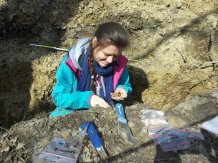EXETER, United Kingdom — A technique that usually helps police investigate crime scenes is now helping scientists examine a different kind of scene — asteroid strikes from the distant past. Researchers at the University of Exeter report that by analyzing the charred remains of plants, they can identify the locations of asteroid strikes from thousands of years ago.
Current estimates of crater-producing asteroid strikes over the past 11,650 years (the Holocene period) only account for about 30 percent of impact sites. Why? Unless scientists found pieces of iron meteorites nearby, there was no agreed-upon way to differentiate between normal land structures and very small asteroid craters.
This latest initiative discovered that the charcoal around craters is actually different from wildfire charcoal – which means analyzing various samples can help researchers establish the origin of those small craters.
“The properties of organisms turned into charcoal reflect the conditions in which they were killed,” says lead study author Dr. Ania Losiak, from the Institute of Geological Sciences, Polish Academy of Sciences, and the University of Exeter, in a university release. “Those conditions, such as the heat the wood was exposed to or the duration of the heating, leave tell-tale signs in the material’s structure.”
“For example, charcoal from low-energy surface fires, like burning bushes and leaves, has different properties than charcoal from high-intensity wildfires,” Losiak continues. “Impact charcoals are very strange. They all look as if they were formed in much lower temperatures than wildfire charcoals, and they are all very similar to each other, while in a wildfire it is common to find strongly charred wood just next to barely affected branches.”

‘We need to look to our planet’s recent past’
The research team dug trenches in rims of four craters, three in Europe and one in North America (Kaali Main and Kaali 2/8 in Estonia, Morasko in Poland, and Whitecourt in Canada).
“The differences between wildfire charcoal and impact charcoal proved to be dramatic and surprising,” explains Professor Claire Belcher, part of Exeter’s Global Systems Institute. “While wildfire charcoal is considerably varied in its reflectivity, depending on the local conditions during the fire, impact charcoals showed uniform characteristics despite coming from completely different locations and being formed thousands of years apart.”
“This presents an opportunity for geologists looking for unrecognized impact craters,” the researcher notes.
“This study improves our understanding of environmental effects of small impact crater formation so that in the future, when we discover an asteroid a few meters across or more coming our way only a couple of weeks before the impact, we will be able to more precisely determine the size and type of evacuation zone necessary,” adds Professor Chris Herd from the University of Alberta.
“Since 1900, two impacts – in Tunguska and Chelyabinsk – caused damage on a massive scale,” Dr. Losiak concludes. “In order to prepare for any future threats, we need to understand how often collisions like that occur. And to do that, we need to look to our planet’s recent past.”
The study is published in the journal Geology.

